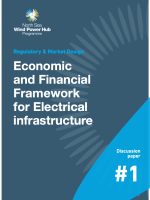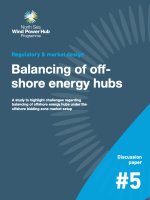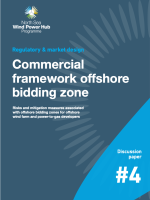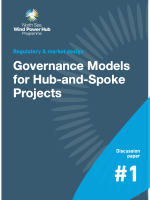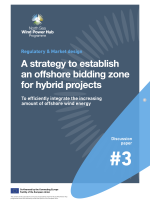Economic and Financial Framework for Electrical infrastructure
Why read this report
For a hub-and-spoke project, the economic and financial framework should be determined before the final investment decision and provide clarity on all financial streams and economic corner stones of support, cost recovery and financing mechanisms. The analyses provided in this document aims to empower policymakers in their decision-making by facilitating a balanced and structured discussion. This paper addresses the suitability of existing frameworks for electricity and gas infrastructure by identifying gaps for hub-and-spoke projects. Furthermore, European funding schemes are de- scribed and their impact on the frameworks is assessed. Also, several aspects to opening up of the regulation congestion income is discussed in light of the expected proposal of the European Commission. Finally, recommendations of next steps are provided.
Highlights
It seems possible to cover the financing and cost recovery of a hub-and-spoke project on a national level due to the assumed configuration and governance model of the project. Only the hub-to-hub or hub-to-shore interconnectors are cross-border and international.
Financing and cost recovery of the hub-and-spoke project may be possible at a national level but leveraging European funding schemes may help reduce the burden on the tariff and tax payers.
The implications of alternative usage of congestion income are far reaching. Other mechanisms might be more suitable to ensure sufficient OWF income and more research is required to examine this.
Executive summary
The increasing demand for renewable energy has driven ambitious goals for offshore wind power in Europe.1 Meeting this demand requires innovative solutions and a new, novel approach including both electricity and (offshore) hydrogen. The North Sea Wind Power Hub (NSWPH) is a consortium formed by TenneT Netherlands, TenneT Germany, Energinet and Gasunie to develop the energy infrastructure for integrating large-scale offshore wind energy from the North Sea into the European energy system. This paper discusses the economic and financial frameworks that are required for the realisation of such a project to provide clarity on the regulatory framework ahead of the necessary investment decisions for project developers. The peculiarities of both electricity and hydrogen require, however, a separate in depth look. The analyses provided in this document therefore aims to empower policymakers in their decision-making by facilitating a balanced and structured discussion, focusing on electricity. Due to the major recent developments on hydrogen on both EU and national level, an additional paper (to be published by NSWPH) will describe how hydrogen can play a role in the overall offshore hub-and-spoke concept.
The economic and financial framework refers to all financial streams and economic corner stones of sup- port, cost recovery and financing mechanisms during three building blocks of a project: planning, owner- ship and system operation. The choice of a suitable economic and financial framework is highly dependent on the governance model of the infrastructure. The governance model defines how ownerships and legal tasks for assets and activities are allocated across different actors and the economic and financial frame- work defines how costs in hub-and-spoke projects can be financed and recovered.
Existing economic and financial frameworks
This paper describes the current national frameworks for electricity in the Netherlands, Germany and Den- mark and analyses how suitable they are for hub-and-spoke projects. Using existing frameworks without requiring many adjustments, facilitates the implementation process and increases the chance that the frame- work is implemented early enough to avoid delay of investment decisions. The national frameworks in the three countries cover the following assets: offshore wind connection, electricity transmission, interconnection, storage and the hub foundation. There are many similarities between the frameworks: electricity transmis- sion, interconnection and OWF connection are regulated third party. All regulated assets need to be included in the investment plans of the TSOs, which in some cases need to be checked and/or approved by the NRAs and ministries. There are also many differences between the frameworks when the details are considered in depth. Most significantly, Denmark only has one framework for all electrical transmission assets whereas Germany and the Netherlands have separate frameworks for the offshore grid and some interconnectors.
The implications of these frameworks are discussed in detail and suggested suitable combinations are outlined. It is generally possible to cover the financing and cost recovery of a hub-and-spoke project on a national level due to the configuration and governance model of the project. Only the hub-to-hub and hub-to-shore interconnectors are international and cross-border whereas all other assets can be seen as national assets. There are a few aspects which require further consideration: i) hub foundation framework in Germany and the Netherlands, ii) possibility of anticipatory investments, and iii) the legal definition of the Dutch offshore grid.
European funding and impact on economic and financial frameworks
Financing and cost recovery of the hub-and-spoke project may be possible at a national level but leveraging European funding schemes may help reduce the burden on the tariff and tax payers. This paper discusses possible European funding frameworks and the most promising are presented in detail. The five European funding schemes that were considered in detail are: The Connecting Europe Facility (CEF), Horizon Europe, EU renewable financing, Recovery and resilience facility, Invest EU and the Innovation Fund. These five were selected as the most relevant and applicable to the NSWPH. The analysis shows that in all countries an European fund can be part of the national economic and financial frameworks. It is, perhaps, surprising that the funds do not have a very large positive impact for the TSO. However they can benefit the public acceptance of large infrastructure projects and the reputation of the developer. However, applying for grants is very time and resource intensive and may not be attractive from a business perspective and may slow down the development of such an innovative project.
Opening up the usage of congestion income and impact on economic and financial frameworks
Finally, the use of congestion income is discussed in light of a EC proposal to be published in 2022 on the alternative uses of congestion income. The European Commission is considering opening the European regulation on usage of congestion income to mitigate the negative impact of an offshore bidding zone on offshore wind farm investment certainty. Differing regulation between the countries causes differences in how congestion income is spent. The implications of the EC proposals are far reaching and are discussed in detail:
- Impact of advanced hybrid coupling on the correlation between congestion income and OWF revenues;
- Furthermore, opening up congestion income regulation can have a negative impact on the compliance with European regulation which stipulates that network charges shall be cost reflective and shall not include unrelated costs supporting unrelated policy objectives;
- The resulting mix up of levies and tariffs when opening congestion income regulation. Especially, the interference of member states in NRA power should be further considered; and
- Finally, other mechanisms might be more suitable to ensure sufficient OWF income than the redistribution of congestion income approach. More research is required to examine this.
